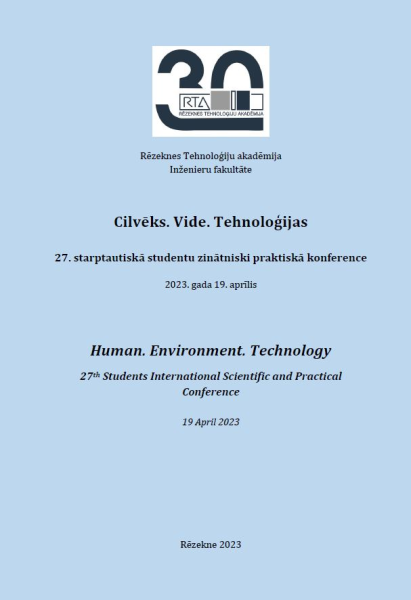COMPARISON OF SILAGE COMPOSITIONS OBTAINED FROM SOWN GRASSES AND NATURAL MEADOW GRASS IN FARM BĒRZI AND FARM LAIMĪTES
DOI:
https://doi.org/10.17770/het2023.27.7372Keywords:
silage quality, feed, greenhouse gas emissions in animal husbandry,Abstract
The paper deals with the methods of improving animal husbandry feed rations in two different farms. Forage quality in herd has enormous impact on methane production all over the world, so it is important to find ways to decrease these numbers and also increase the productivity of the whole herd. As a result of research, the chemical composition of the different kind silage of sown grasses and natural meadows will be clarified and proposals are developed for improvement the quality of feed for herd productivity increase.Downloads
References
Beča M. (2004)Proteīna un aminoskābju satura izmaiņas dažādu zelmeņu zāles skābbarībā tās sagatavošanas procesā: promocijas darbs Dr. Agr. zinātniskā grāda ieguvei. Latvijas Lauksaimniecības universitāte. Jelgava. 98 lpp.
Bimšteine Z., Labāka barībs sagremojamība, lielāka ražība, mazāk izdalīta metāna. Latvijas Lopkopis. NR9 (71)2020 16.-18.lpp)
Cushnahan A., Mayne C. S., Unsworth E.F. (1995). Effects of ensilage of grass on performance and nutrient utilisation by dairy cattle.2. nutrient metabolism and rumen fermentation. Animal Science, Vol.60, p.347-359.
Degola L., Aplociņa E., Trūpa A. (2016) Forage quality and digestibility for calculation of enteric methane emission from cattle.No: Līdzsvarota lauksaimniecība, Zinātniski praktiskās konferences raksti (2016. g. 25. – 26. febr.). Jelgava: LLU, 456-461 lpp
Degola L., Aplociņa E., Trūpa A., Cielava L. (2016) Barības devas dažāda lieluma piena lopkopības saimniecībā. No: Līdzsvarota lauksaimniecība, Zinātniski praktiskās konferences raksti (2016. g. 25. – 26. febr.). Jelgava: LLU, 161 – 167 lpp
Grīslis Z., Garkāvijs E., Sprūžs J, 1991 Lopkopība. Mācību līdzeklis. Rīga. 355 lpp.
Klimatam draudzīga lauksaimniecības prakse Latvijā. Lopbarības kvalitātes uzlabošana. Poplugas D., Kreišmanes Dz.red. LLU, 2020. 12lpp.
Kreišmane Dz. SEG emisijas, to ierobežošana. Siltumnīcas efekta gāzu emisijas radīto klimata izmaiņu ietekme uz lauksaimniecību un tās pielāgošanas iespējas. Zinātniski praktiskā konference “Līdzsvarota lauksaimniecība 2015”, 19. – 20.02.2015., LLU, Jelgava.
Latvietis J. (2011) Kā ēdināsim, cik slauksim?, Agro tops, Nr. 3., 50.-51.,lpp
Marley C.L., Powell H.G., Theobald V.J., Davies J.W., Scollan N.D., Sanderson R. Fychan R. (2016) Effects of feeding red clover compared to ryegrass silage to growing cattle out-wintered on kale. Grassland Science in Europe. Vol. 21, p. 406-408.
McDonald P., Henderson A. R., Heron S. J. E.(1991) The Biochemistry of Silage (Second Edition). Marlow, Bucks, UK: Chalcombe Publications.
Meissner H.H., Paulsmeier D.V. (1995) Plant compositional constituents affecting between-plant and animal species prediction of forage intake. Journal of Animal Science, Vol 73, p. 2447-2457.
Mertens D.R. (2009) Maximizing forage use by dairy cows. WCDS Advances in Dairy Technology, Vol 21, p. 303-319.
Nadeau E. (2007) Effects of plant species, stageof maturity and additive on the feedingvalue of whole-crop cereal silage. Journal of Dairy Science. Vol. 87, p. 789–801
Nazir A Khan, Peiqiang Yu, Mubarak Ali, John W. Coneaand Wouter, H. Hendriks (2014) Nutritive value of maize silage in relationto dairy cow performance and milk quality. Journal of Dairy Science. Vol. 95, p. 238–25
Osītis U. (2005). Dzīvnieku ēdināšana kompleksā skatījumā: Mācību grāmata. Jelgava, 320 lpp
Ošmane B., Ramane I. (2004). Enerģētiskā un proteīna bilance atšķirīgās veģetācijas fāzēs novāktās stiebrzālēs un no tām dažādi gatavotās skābbarībās.LLU Raksti. 30-35 lpp.
Pastuhovs, M., Rokasgrāmata piemājas lopkopībā, 1984,18.lpp
Wangsness P. J., Muller L. D. (1981) Maximum forage for, dairy cows. Journal of Dairy Science. Vol. 64, p. 1-13
Wright, Gordon, Steen, Patterson (2000). Factors influencing the response in intake of silage and animal performance after wilting of grass before ensiling. Journal of Dairy Science. Vol 57, p. 32-45
Zālāju rokasgrāmata (2016) Anševica A., Kažotnieks J., Magdalenoka I. Ozolnieki: LLKC, 78lpp.
AGRO TOPS, 2019, novembra izdevums . Pieejams: https://izdevumi.latvijasmediji.lv/izdevumi/at/2019/11/01/5
Dreijere S., 2019. Barības devas un slāpekļa emisijas. Pieejams: https://zemniekusaeima.lv/wp-content/uploads/2019/01/Bar%C4%ABbas-devas-un-sl%C4%81pek%C4%BCa-emisijas_LLKC_FIN.pdf


